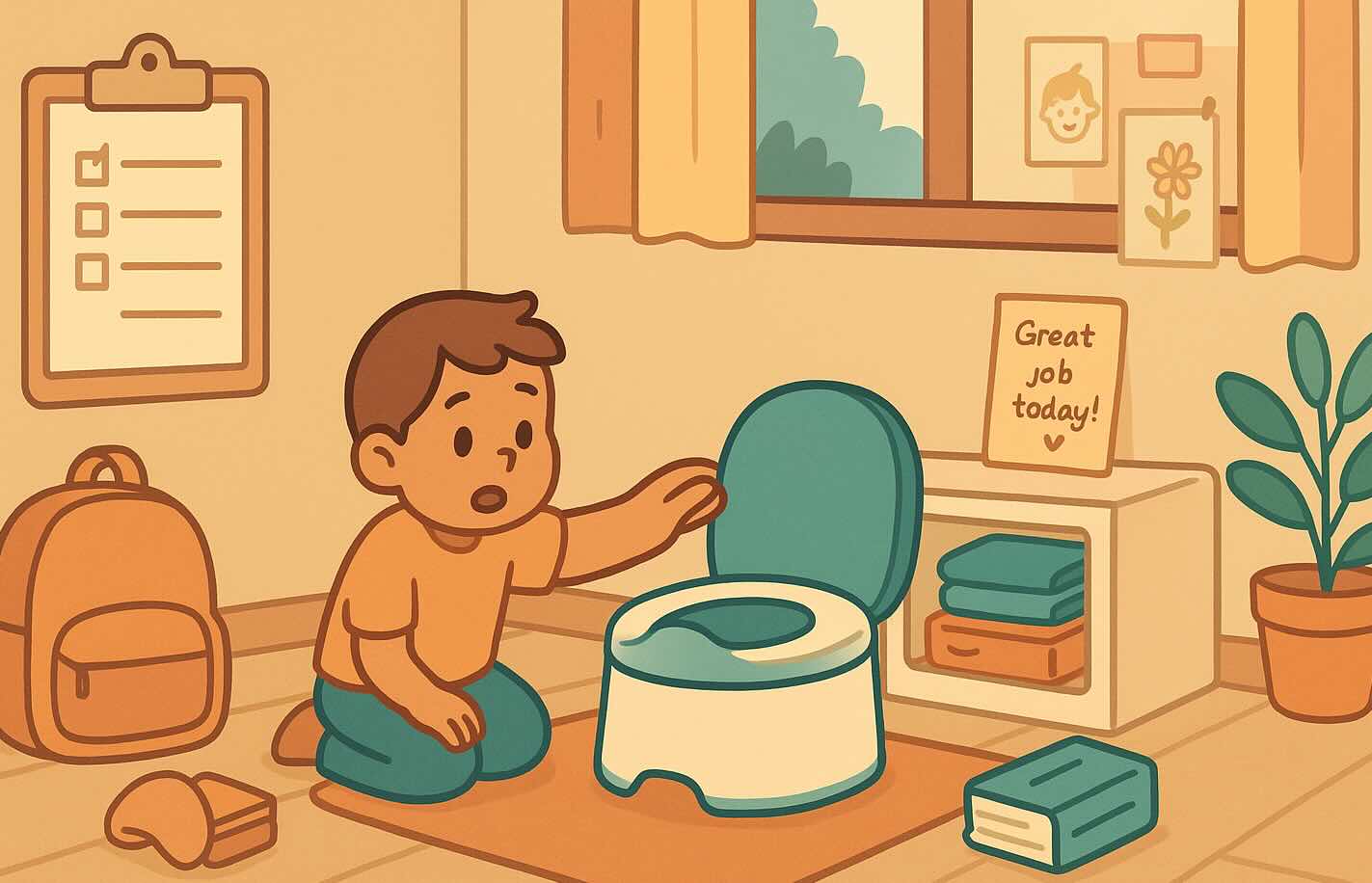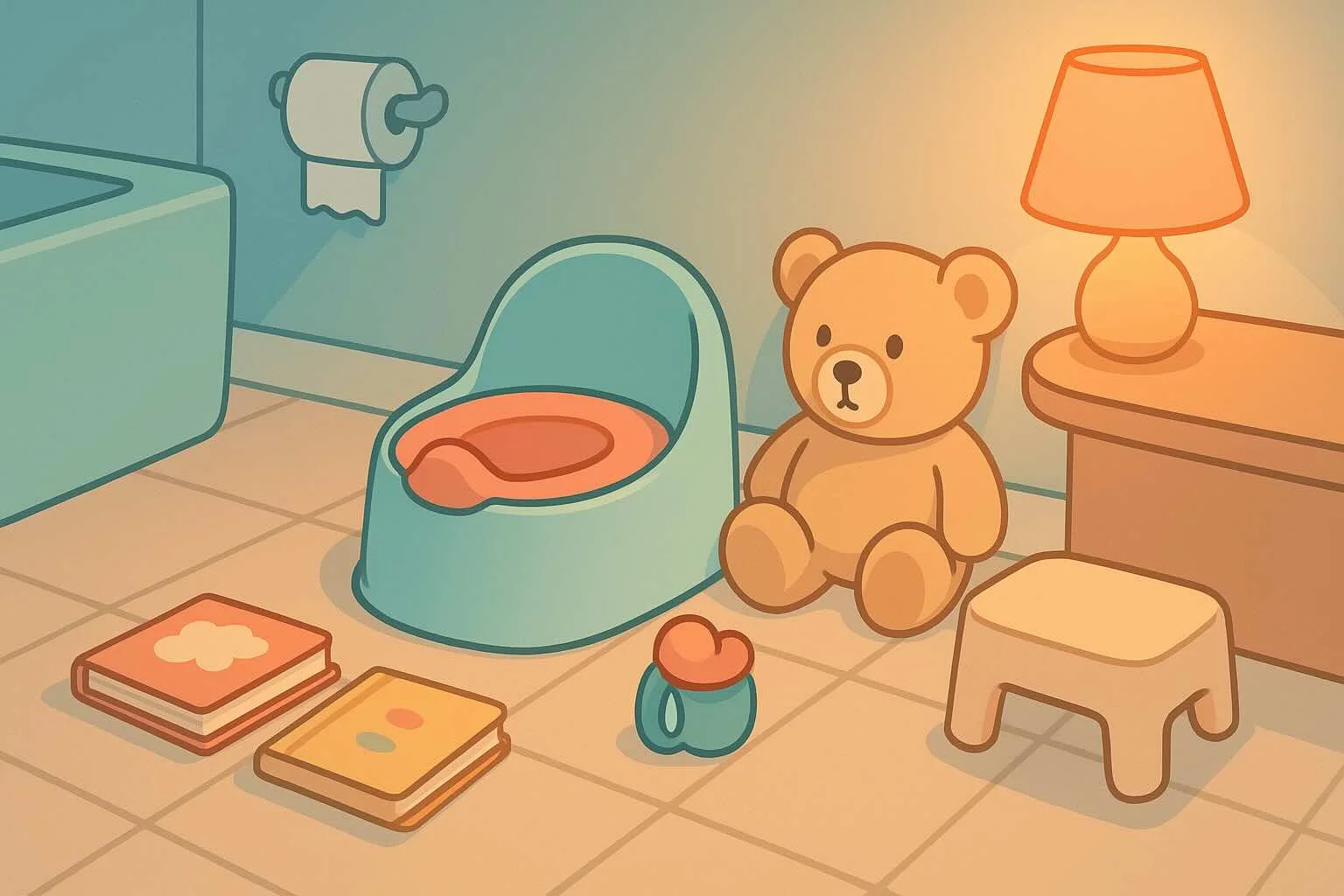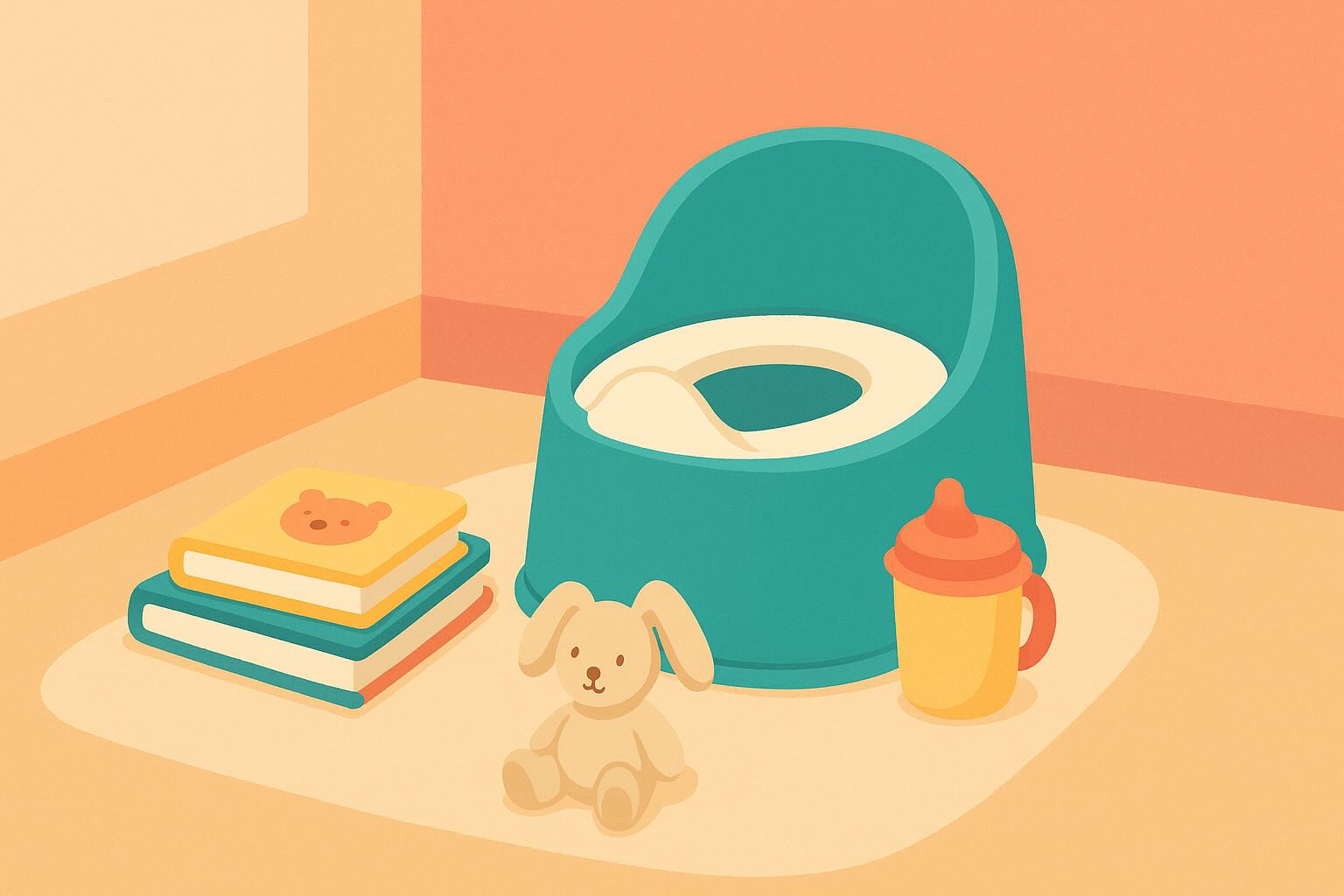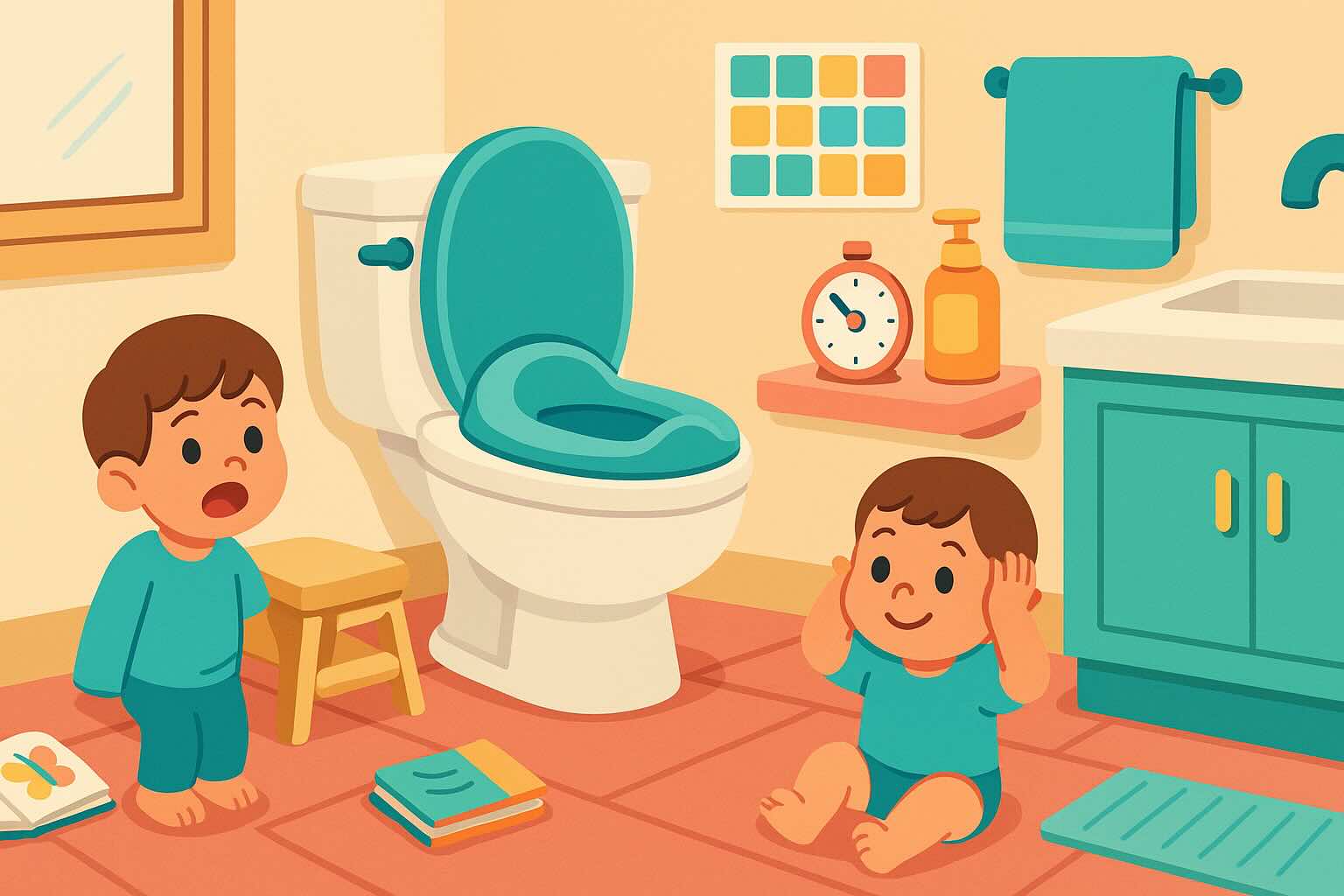Daycare Potty Training Requirements: Meeting Deadlines Without Pressure


Your daycare director just handed you a letter: "To move to the preschool room, children must be fully potty trained by their third birthday."
You look at your 2.5-year-old who just yesterday used the toilet twice, then had three accidents. The pressure settles in your chest: We have six months. What if we don't make it?
Or perhaps you're already past the deadline, negotiating extensions and feeling the weight of "we really need this to happen" from your provider, your child, and yourself.
The intersection of daycare requirements and potty training readiness is one of the most stressful challenges parents face. You're trying to balance your child's developmental timeline with institutional deadlines, maintain your relationship with your provider, and avoid turning bathroom use into a power struggle.
Here's what I've learned supporting families through this transition: it's possible to meet daycare requirements without sacrificing your child's confidence or your sanity—but it requires strategic planning, clear communication, and sometimes, advocacy.
This guide will help you navigate timelines, create home-daycare consistency, communicate effectively with providers, and know when to push back on policies that don't serve your child.
Understanding Daycare Potty Requirements
Before we dive into strategies, let's understand why these requirements exist and what they typically entail.
Why Preschools Have Potty Training Deadlines
When centers say "potty trained required for the 3-year-old room," they're usually responding to several practical constraints:
Staffing ratios: Preschool classrooms typically have higher child-to-teacher ratios (often 1:10 or 1:12) compared to toddler rooms (1:4 to 1:6). Teachers don't have the capacity to change diapers for multiple children while supervising a larger group.
Facility limitations: Many preschool bathrooms aren't equipped with changing tables, and licensing regulations often prohibit diapering children over a certain age in rooms without proper facilities.
Developmental programming: Preschool curricula often assume children have mastered basic self-care skills and can participate in bathroom routines somewhat independently.
State regulations: Some states have specific licensing requirements about diapering children over age 3 in group care settings, particularly in preschool classrooms.
Understanding these constraints doesn't mean you can't negotiate, but it helps you approach conversations from a place of partnership rather than opposition.
What "Potty Trained" Typically Means
Different programs define "potty trained" differently. Before you panic about the deadline, clarify what your specific program requires:
Some programs mean:
- Stays in underwear all day (no pull-ups except possibly nap)
- Uses the toilet when prompted by teachers
- Can pull pants up and down with minimal help
- Communicates need to use bathroom (with words or signs)
- Has fewer than 1-2 accidents per week
Other programs mean:
- Initiates bathroom trips independently without prompting
- Manages entire bathroom routine alone (undressing, wiping, redressing, handwashing)
- Never has accidents
- Uses the toilet for both pee and poop consistently
The difference matters enormously for your timeline and stress level. Get specific details in writing from your program.
The "Working On It" Grace Period
Many (though not all) programs have an unofficial grace period where children can start the new classroom in pull-ups or with frequent accidents, as long as they're "actively working on" potty training and making progress.
Ask specifically:
- "What does the first month look like for a child who's learning but not fully independent?"
- "How many accidents per week are acceptable during the transition period?"
- "Is there a specific timeline when you'd need to see complete independence?"
This information helps you plan a realistic timeline rather than assuming you need perfection by day one.
Timeline Planning: Working Backward from the Deadline
If you have a specific deadline (moving to preschool room, starting a new program, aging out of the toddler room), working backward helps you create a strategic plan.
6 Months Before Deadline: Assessment Phase
Your focus: Determine if your child is showing readiness signs and whether 6 months is a reasonable timeline.
Key questions:
- Can your child stay dry for 1-2 hours at a time? (bladder readiness)
- Can they pull pants up and down independently or with minimal help? (motor skills)
- Do they show interest in the toilet or awareness when they're going? (cognitive readiness)
- Can they follow simple two-step directions? (receptive language)
If you see 3-4 of these signs: Six months is likely enough time with a relaxed, interest-led approach.
If you see 0-2 of these signs: Talk to your provider now about possible extensions or alternative plans. Trying to force training on an unready child often backfires with power struggles and regression.
4-5 Months Before Deadline: Building Foundation
Your focus: Create familiarity and interest without pressure.
What this looks like:
- Read potty books together regularly
- Let your child observe you or older siblings using the bathroom (if they're interested)
- Talk casually about how "someday you'll use the potty too"
- Introduce the toilet or potty chair as something available, but don't require sitting
- Notice and narrate when your child is peeing/pooping: "I see you're going pee. Your body is telling you what it needs"
The goal: Normalize the toilet and build positive associations before asking your child to actually use it.
3 Months Before Deadline: Active Learning Phase
Your focus: Begin offering opportunities and celebrating successes without forcing.
What this looks like:
- Offer potty sits at key times (waking, before bath, after meals) but accept "no"
- When your child successfully uses the potty, celebrate warmly
- Don't punish accidents—just clean up matter-of-factly
- Consider switching to pull-ups during the day so your child can practice pulling them up and down
- Talk about the upcoming classroom transition: "When you're ready, you'll move to the preschool room where kids use the potty"
If things are going well by 2 months before deadline: Increase frequency of offers and start expecting underwear for longer periods (mornings, then full days)
If your child is resisting or showing few signs of success: Reassess whether the timeline is realistic and communicate with your provider about needing more time.
1 Month Before Deadline: Intensification or Adjustment
If your child is showing readiness and making progress:
This is the time to increase expectations and practice consistency:
- Transition to underwear for most of the day (pull-ups for naps/outings if needed)
- Offer potty opportunities every 1-2 hours consistently
- Practice the daycare bathroom routine (group transitions, waiting in line, limited privacy)
- Pack the daycare accident bag together so your child knows what to expect
If your child isn't making progress or is actively resistant:
This is the time to have an honest conversation with your provider:
- Share specific data on what you've tried and what's happening
- Ask about flexibility, extensions, or alternative plans
- Discuss whether starting preschool in pull-ups is possible with a specific transition timeline
- Consider whether delaying the classroom transition is the healthiest option for your child
The key: Don't panic-push in the final month if the foundation isn't there. Last-minute pressure often causes power struggles that set back progress.
Creating Home-Daycare Consistency
One of the biggest challenges is managing different expectations and routines between home and daycare.
The Pre-Training Conversation with Providers
Before you actively start potty training, schedule a conversation with your child's teachers. Come prepared with questions:
About their approach:
- "How do you typically support children learning to use the potty?"
- "What language do you use (potty/toilet/bathroom)?"
- "Do you use rewards or incentives?"
- "How do you handle accidents?"
- "How often do you offer potty opportunities during the day?"
About logistics:
- "What should I pack in the accident bag?"
- "How do you communicate with parents about potty progress (daily sheets, apps, verbal updates)?"
- "Can teachers prompt my child individually or is it only group bathroom times?"
- "What happens if my child has multiple accidents in one day?"
Share your approach:
- "At home, we're using this approach..."
- "These strategies seem to work for our child..."
- "These are our child's current abilities and challenges..."
- "This is our tentative timeline..."
The goal: Create alignment where possible and identify where differences exist so you can explain them to your child.
What to Do When Approaches Differ
Perfect consistency between home and daycare isn't always possible—or necessary. Children can learn "different rules in different places" as long as both environments are supportive.
Where consistency matters most:
- Emotional tone: Both home and daycare should be calm, supportive, and free from shame about accidents
- Basic language: Using the same main words (potty vs. toilet, pee-pee vs. urine) reduces confusion
- Physical routine: If possible, similar sequence (try, wipe, flush, wash hands, celebrate)
Where differences are okay:
- Reward systems: Daycare uses stickers, home uses high-fives = fine
- Timing: Home offers every 90 minutes, daycare does group transitions = fine
- Privacy: Home bathroom has a door that closes, daycare has stalls or open toilets = fine
How to explain differences to your child:
- "At school, everyone goes to the bathroom together before snack. At home, you can go whenever you need to."
- "Your teachers use stickers for potty time. At home, we do special handshakes. Both are ways to celebrate!"
- "At school, there are lots of friends in the bathroom. At home, you can close the door if you want privacy."
Children are remarkably adaptable to different expectations in different contexts, as long as both environments feel safe.
The Communication Loop
Effective potty training with daycare involvement requires ongoing communication:
Daily updates you should receive:
- Number of successful toilet uses
- Number of accidents and approximate times
- Any resistance or emotional responses
- What your child ate/drank (helps predict bathroom needs)
Weekly check-ins you should initiate:
- "How is the potty routine going at school?"
- "Are you seeing any patterns we should address?"
- "Is there anything you need from us at home to support what's happening at school?"
If communication is lacking: Request specific formats (daily sheet with checkboxes, app updates, brief verbal check-ins at pickup). Explain: "I need this information to support consistency at home."
Handling Pressure Without Creating Power Struggles
When a deadline looms and your child isn't progressing as hoped, the pressure can lead to approaches that backfire.
What Pressure Looks Like (And Why It Doesn't Work)
Pressure approaches that backfire:
- "You HAVE to use the potty or you can't go to preschool"
- Punishing accidents with loss of privileges or time-outs
- Forcing a child to sit on the toilet for extended periods
- Comparing to siblings or peers ("Your friend is already trained!")
- Making bathroom use a battle of wills
Why these don't work: Potty training requires a child to release control of their sphincter muscles, which is impossible when they're in a stressed, defensive state. The more you push, the more they resist—and the longer the process takes.
What Support Looks Like Instead
Supportive approaches that work:
- "The preschool room has a bathroom just for kids. Let's visit it together sometime."
- Responding to accidents with calm cleanup: "Accidents happen when you're learning. Let's get you dry clothes."
- Offering opportunities and celebrating successes without demands
- Acknowledging feelings: "I know this feels like a lot to learn. You're doing your best."
- Shifting your own expectations: "We're learning this skill. The timeline matters less than my child's confidence."
The paradox: The less you push, the faster most children learn, because they're relaxed enough to notice their body signals and motivated by genuine interest rather than fear.
When the Deadline Arrives and Your Child Isn't Ready
This is the moment of truth: the classroom transition date has arrived, and your child is still having daily accidents or actively resisting the potty.
You have several options:
Option 1: Request an Extension
- Many programs will grant 1-2 month extensions if you have a specific plan and show active effort
- Come prepared: "We're working on this daily. She's dry 60% of the time now. Could we have 8 more weeks with weekly progress check-ins?"
Option 2: Start with Pull-Ups
- Some programs allow children to start the new classroom in pull-ups with a specific timeline for transitioning to underwear
- Propose: "Could she start in pull-ups with the agreement that we'll transition to underwear within 6 weeks?"
Option 3: Delay the Classroom Transition
- If your child truly isn't ready (showing few readiness signs, significant resistance), staying in the current classroom longer may be healthier
- Consider: Is another 2-3 months in the toddler room worth avoiding a traumatic or shame-filled transition?
Option 4: Find Alternative Care
- If the program isn't flexible and your child isn't ready, you may need to find a program with different policies
- Some programs specialize in toilet learning support and have no age-based requirements
The principle: Your child's emotional wellbeing and confidence matter more than meeting arbitrary deadlines.
Advocating for Your Child
Sometimes, you need to push back on policies or approaches that don't serve your child's needs.
When to Advocate
Consider advocating if:
- The program's timeline expectations don't align with typical child development (expecting full training by age 2.5)
- Teachers are shaming, punishing, or expressing frustration about accidents
- Your child is showing signs of stress or fear about bathroom use that started after beginning at the program
- The program is inflexible about individual differences (treating all children exactly the same regardless of readiness)
- Your child has special needs or developmental delays that affect potty training timeline
How to Advocate Effectively
Come Prepared with Information
- Data on your child's current abilities and progress
- Research on typical potty training timelines (AAP recommendations, developmental guidelines)
- Specific requests for modification or accommodation
- Documentation of any concerning interactions you've observed or heard about
Use Collaborative Language
- "I'm noticing... and I'm concerned about... Can we discuss how to support my child differently?"
- "I understand the policy exists for good reasons. I'm wondering if there's flexibility for individual circumstances?"
- "What would need to happen for us to find a solution that works for the program and my child?"
Know Your Rights
- If your child has a diagnosed developmental delay or disability, you may be entitled to accommodations under ADA
- State licensing regulations often include provisions about respectful care and emotional safety
- Program contracts typically include dispute resolution processes
Escalate When Necessary
- If classroom teachers aren't responsive, speak to directors
- If directors aren't responsive, review program policies and licensing requirements
- If you observe harmful practices (shaming, punishment), document and report to licensing authorities
The goal: Find a solution that honors your child's developmental needs while acknowledging the program's constraints.
Red Flags That Indicate You Should Find Different Care
Consider leaving a program if:
- Teachers regularly shame or punish children for accidents
- The program is completely inflexible about individual timelines without legitimate reason
- You observe or hear about unsafe or disrespectful bathroom practices
- Your child develops fear or anxiety about bathroom use that didn't exist before this program
- Communication is hostile or dismissive when you raise concerns
Your child deserves care that supports their development with patience and respect, not pressure and shame.
Success Stories: What's Possible with Partnership
When home and daycare work together, potty training can happen smoothly even with deadline pressure:
Mia's story: Her preschool required training by age 3. At 2.5, she showed few readiness signs. Her mom talked to the director, got a 4-month extension, and worked closely with teachers on a consistent approach. Mia transitioned to the preschool room at 3 years, 4 months, fully confident and trained—and the program celebrated the partnership that made it work.
James's story: He started preschool in pull-ups because he had autism and wasn't developmentally ready for full training at 3. His teachers and parents agreed on a 6-month plan with specific milestones. By 3.5, he was fully independent. The program's willingness to accommodate his individual timeline made the difference.
Ava's story: Her daycare teachers used rewards and group bathroom times, while her parents preferred interest-led learning at home. Both approaches worked because both environments were supportive, and Ava learned that "different places have different routines." She was fully trained by 3 years, 2 months.
The common thread: In each case, adults worked together with flexibility and respect for the child's individual timeline.
The Bottom Line: Timelines Matter Less Than Confidence
Your child will eventually use the toilet independently, regardless of whether they meet the preschool deadline by a day, a week, or a month.
What matters more:
- That they learn bathroom use is a normal, shame-free part of life
- That they maintain confidence in their ability to learn new skills
- That you maintain a positive relationship with them through the process
- That they don't develop fear or anxiety around bathroom use
Sometimes that means meeting the deadline with creative solutions and hard work. Sometimes that means advocating for extensions or modifications. And sometimes that means choosing different care arrangements that better fit your child's timeline.
All of these are okay.
You know your child best. Trust yourself to make decisions that honor their developmental needs, even when those decisions feel inconvenient or different from the prescribed path.
The classroom will still be there when your child is ready. And they'll get there with confidence intact.
Related Resources
- Potty Learning Complete Guide - Comprehensive overview of the entire potty learning journey
- 2 Year Old Potty Training Guide - Age-specific guidance for 2-year-olds
- 3 Year Old Potty Training Guide - Strategies for 3-year-olds approaching preschool
- 4 Year Old Not Potty Trained Guide - Support for children past typical deadlines
- Potty Training Regression Guide - Handling setbacks during daycare transitions
- Potty Training Accidents Guide - Managing accidents with calm confidence
Complete Potty Learning Toolkit
Readiness assessments, age-specific strategies, and practical scripts to support your child's potty learning journey.
Need personalized support?
RootWise's AI coach can provide tailored strategies for your specific situation, available 24/7 when you need it most.
Learn More About AI Coaching →



